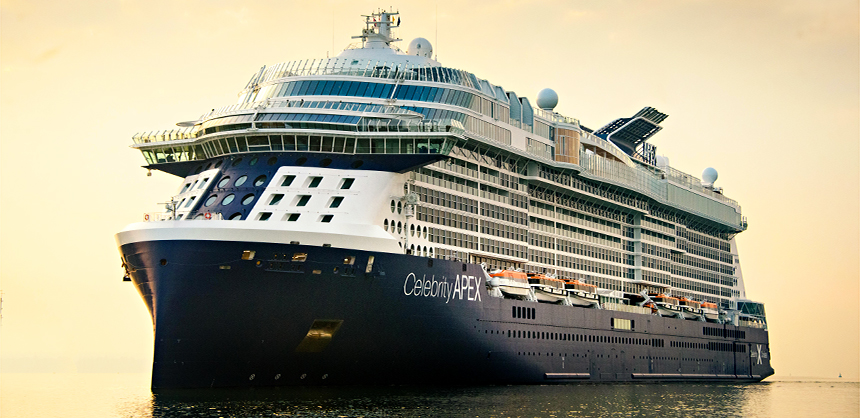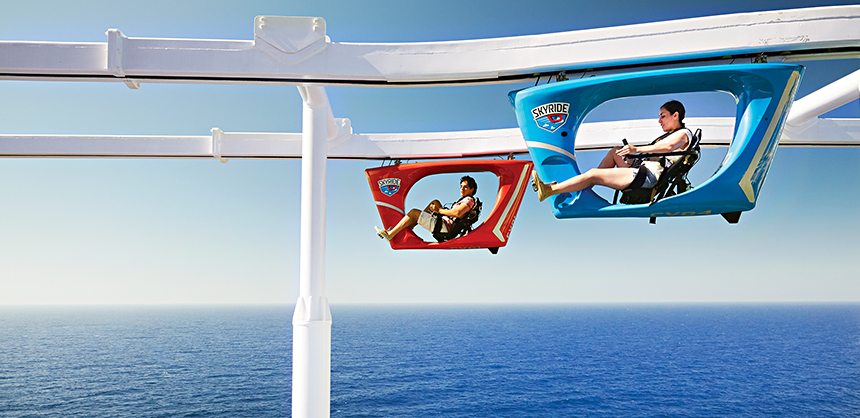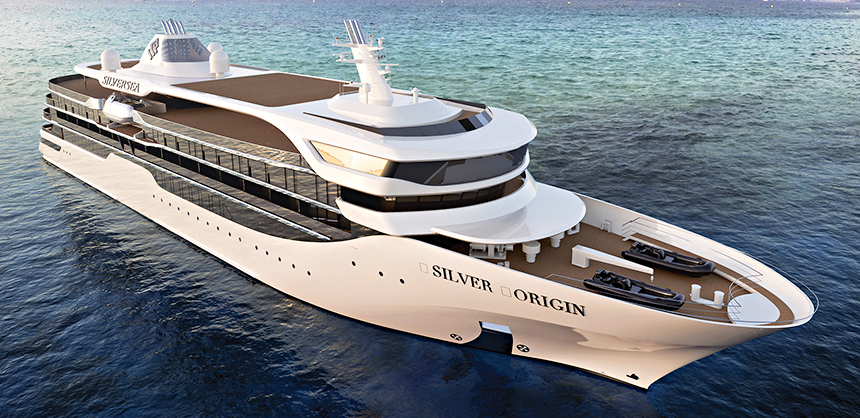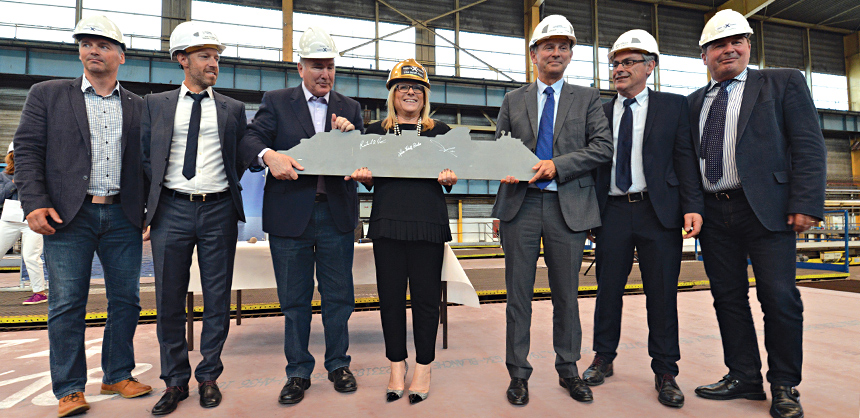Ready To LaunchFebruary 15, 2021
Cruise Lines Preparing For The Return Of Incentive And Meeting Groups By David SwansonReady To Launch
Cruise Lines Preparing For The Return Of Incentive And Meeting Groups
Celebrity Apex, AX, ship exterior, aerial, drone
Everyone is tired of the endless Zoom conferences. We’re all aching to meet in person.
As the U.S. nears the one-year mark of the pandemic shutdown, and vaccines move into broader distribution, the travel industry is evaluating how and where it can safely restart. For the meetings sector, the coronavirus has been devastating, as planners have contended with repeated conference cancellations and/or an ongoing series of pivots to online and hybrid events.
Staycations and regional travel have planted the seeds for opening up, and as airline routes come back and conference facilities find their way to the “new normal,” opportunities to meet face-to-face and interact with our work colleagues are starting to feel close at hand. Such green shoots bode well for the rebirth of the meetings and incentives industry this year. And right alongside, cruise lines are also readying ships to sail again, hoping to recapture their piece of the lucrative conference and incentive market.
This may seem surprising. Some of the more problematic instances of the coronavirus entering the U.S. originated on cruise ships at the beginning of the pandemic. On March 14, the Centers for Disease Control and Prevention (CDC) announced a No Sail Order covering all cruises departing U.S. ports. Since, cruise lines have been cancelling departures one or two months at a time as the pandemic unfolded. On October 31, the CDC let its No Sail Order expire, replacing it with a Framework for Conditional Sailing Order which establishes provisions for the industry’s restart.
When it comes to getting out to see the world, the open ocean is calling, and Joyce Landry, CEO of Landry & Kling Global Cruise Services and Sustainable Ships, says she will feel much safer on a cruise ship than many other places in the post-COVID-19 world. “The cruise lines are being scrutinized more than anybody else,” says Landry, who specializes in cruise groups and charters. “They’re under the microscope, and there’s not going to be a hotel or a conveyance, or even an airport that’s going to be as tight as the cruise industry coming back. If I were a meeting planner and looking for a safe destination that I could really count on, it would be a cruise.”
But the CDC is not making the restart easy, having laid out a complex series of steps that must be navigated before sailings can resume from U.S. ports. “The conditional sail order outlined a very rigorous course for their return, and it’s going to take a while,” says Colleen McDaniel, editor-in-chief of Cruise Critic, the leading consumer information website for cruisers. “The ships will be required to do short test cruises. This will give cruise lines the ability to try things out, but they’re not going to be traditional pleasure cruises.”
McDaniel continues: “Every cruise line has said they’re going to take a staggered approach to their return. They’ll start with one or two ships and slowly add more; it won’t be the full fleet, and they won’t be sailing at full capacity. But Arnold Donald, [CEO of Carnival Corporation], said in his January earnings call that they wanted to have all of their ships sailing by the end of the year. I think that’s an admirable goal, and we’d all love to see that, but it is really dependent on how quickly they can move through the conditional sail order. There are things that are well beyond their control.”

Carnival offers the SkyRide on its three Vista-class ships, which are Horizon, Vista and Panorama.
Some Success Overseas
Still, the light at the end of the tunnel for cruising’s return is burning a little brighter with each passing week — overseas, at least. The CDC can look to the success of TUI Cruises as one guide for how cruise ships can set sail safely. Since the German line’s return to service in July, TUI Cruises operated 56 cruises last year carrying a total of 53,654 passengers. “There has not been a single positive case among guests during any of those 56 cruises,” says Marcus Puttich, head of port & ground operations for TUI Cruises. “The procedures we’ve used — before you arrive, inside the terminal, onboard, with tours, and with our transportation to the ship — show that cruising is possible under COVID-19 conditions.”
How have they done it? TUI Cruises’ crew was required to have a negative PCR test prior to the start of their contract and were then quarantined for 14 days in a single balcony cabin before interacting with guests. Passengers were required to have a negative test prior to boarding, and the ships’ 2,894-guest capacity was reduced by almost 50%. The initial cruises, ranging from two to seven days, offered no ports for disembarkation or shore excursions.
Other procedures employed onboard include staggered and contactless embarkation, a secondary medical screening in the terminal if needed, physical distancing of approximately 5 to 9 feet, depending on where you are on the ship, and the addition of an infection control officer to monitor compliance and training. Face masks are required where physical distancing is not possible, such as in corridors and elevators.
Similar success has been achieved with Royal Caribbean’s relaunch of cruises out of Singapore on December 1, aboard the 4,180-passenger Quantum of the Seas. Following its overall success containing the coronavirus, Singapore health and tourism authorities worked with Royal Caribbean to develop procedures for the cruises, which included a wearable device for guests to assist with contact tracing in the event of an outbreak. Other protocols include pre- and post-cruise testing for all passengers, upgraded HVAC systems, capacity limited to 50% and stringent cleaning procedures.
McDaniel suggests the cruise industry has long been held to a higher standard than other tourism entities. “Cruise lines have always put health and safety as their highest priority,” she explains. For example, norovirus outbreaks are reported when they happen on ships, often becoming front-page news. Less well known is that, according to the CDC, a majority of norovirus outbreaks occur in long-term care facilities for the elderly. Hotels are another place where outbreaks can escape scrutiny.
Cruise lines have so far not shared much information about what new products they are investing in or how HVAC systems are being adapted to minimize the spread of the virus, but the industry’s sanitation protocols were ahead of other travel sectors even before the pandemic. Guests were required to use hand sanitizers before entering restaurants, and hand-washing stations have been standard in buffet restaurants.
The industry also funds the CDC’s Vessel Sanitation Program, which monitors and investigates gastrointestinal illnesses, trains crew on public health practices and conducts periodic, unannounced ship sanitation inspections on cruise ships operating in U.S. waters. Cruise lines pay for the inspections — as much as $23,920 for the largest vessels — and ships receiving a score of 85 or lower on a scale of 100 are deemed “unsatisfactory.”
Some cruise lines have a head start on some of the technology that will help keep the coronavirus at bay. “Cruise lines have used this opportunity to look at their products,” McDaniel says. “That’s the unheralded story in all of this. We’re going to come back and see their technology has evolved.”
Princess Cruises started to roll out its Ocean Medallion program a couple of years ago. The poker chip-sized device is carried by passengers in lieu of a room key, and each one is linked to a platform on the ship. The medallion unlocks the cabin door and, when connected to an app on a mobile phone, can order drinks to be delivered anywhere on the ship. Passengers can communicate with other passengers, and it serves as a wayfinder. But, while not specifically designed to cope with a pandemic, the Ocean Medallion will also serve as a vital tool for emergencies, such as contact tracing in the event of an outbreak, as it can locate any passenger on the ship and identify where they’ve been and with whom they’ve been in contact.
“Cruise lines are going to use technology in new ways,” McDaniel says. “The ships are moving toward a more touchless, seamless experience, and I think that’s what people are going to be craving right out of the gate. Traditionally, onboard, if you have a problem, you go to the front desk and wait in line to speak to somebody face to face. Now, people are going to be able to solve problems more efficiently using the app — they don’t have to wait on the phone or stand in line — and if there’s a medical emergency, they’ll be able to do contact tracing.”

The 100-passenger Silver Origin is set to debut this year, and will be dedicated to the Galápagos Islands.
Cruise Ships Have Many Benefits
The benefits of using cruise ships for meeting and incentive programs aren’t new, and a growing number of companies are finding that ships offer an edge over traditional land-based programs. One reason is that cruise events can be more cost-effective, and myriad expenses are better controlled. “Venues on the ship are free to use, and so is most of the equipment,” says Diana Bloss, director of operations for Worldwide Cruise Associates. “With less staff needed on your part, and complimentary use of venues, a cruise is definitely cheaper than a land-based option. From experience, it is more streamlined, and there are fewer moving parts and people involved to produce a really successful event.”
A small incentive group of 32 top advertisers from a West Coast TV station are going forward with a sailing in May, using Windstar Cruises’ 312-passenger Wind Surf. Bloss says it was originally set for last spring, but was moved to this year. She adds, “The participants are well traveled internationally, they want luxury, an interesting destination and a ‘wow’ event. We suggested one of the sailing vessels of Windstar, the Riviera, and the Monaco Grand Prix. In prior years, the client had been to other major sporting events, so this was a perfect fit.”
Bloss says the group counts on networking, so social gatherings such as cocktail parties, group dinners and a shoreside event are key factors in planning. “Windstar’s sailing vessels are perfect for a small group — small enough that you still get the yacht-like intimate atmosphere and personal touch versus being on a larger vessel where a group can get lost. Service and food are excellent, with globally sourced ingredients crafted to highlight the regional flavors, and on certain itineraries, you can even accompany the chef to a local market.”
Bloss continues: “The ship’s crew gets to know everyone very quickly, but entertainment is not a big thing, as the key attraction is the small, quaint and out-of-the-way ports that they can go to. The itineraries are different, and you get the true feeling for the countries you visit, rather than the all-too-popular large cities. Of course, it’s always nice to take advantage of an event that is costing millions and being staged by someone else.”
Windstar’s trademark silhouette is offered by a trio of sailing ships, ranging from 148 to 312 passengers. A few years ago, the line acquired three 212-passenger ships from Seabourn. During the pandemic, all three have gone into dry dock for a multi-month lengthening process, a $250 million initiative to add 50 cabins to each ship. The extension includes two new dining options and new engines using cleaner technology. All three will reemerge this summer, and the entire fleet’s HVAC systems have been upgraded with hospital-grade HEPA filters and a UV-C air zapping system.
Landry is also sold on Windstar, having celebrated both her 40th and 50th birthdays sailing with the line. “For a personal vacation, when I want to get away from it all, I would look at Windstar as one of my top, top choices,” Landry says.
Another cruise line she looks to for her groups is Celebrity Cruises. “They’re very good to charter, with a charter department staffed with people who understand what it means — we don’t have to train somebody,” she says. “They offer flexibility in their pricing and processes, and they’ll bend those kinds of policies for us. Contractual policies are sometimes very hard and fast, but with certain cruise lines, we have direct contact with their legal team, and we can sit down with them and express why a particular client must have a clause in their contract.”
Landry notes that Celebrity shares a legal team with Royal Caribbean International, another line with which she often works. “The ships they build are out of this world for groups,” Landry adds. “There are so many entertainment venues that can be customized, that you can take over privately, so you don’t need to charter. We love the Royal Caribbean vessels that have the Studio B ice skating rink. You can put a wood floor over the ice, and bring a group of 400 in, and turn it into an event venue with stadium seating. The corporate meetings and incentive market doesn’t usually want seven days, and Royal Caribbean does a lot of short cruises. If someone is doing a large group or incentive program they usually want four or five nights.”
This past year, Landry & Kling has been doing a series of webinars on sustainability in cruising, focusing on lines Landry thinks are leading the way, in both sustainability and safety protocols. The small-ship French line Ponant is one she cites as a leader, along with Hurtigruten, which has grown from being strictly a Norwegian ferry operator into a leading expedition cruise company specializing in cruising to the polar regions. “Celebrity has also made a real statement,” Landry says. “Lisa Lutoff-Perlo [Celebrity’s CEO] wants everything that touches their ships to be environmentally sound and safe, with really good protocols. They’re doing a good job.”

Celebrity Cruises is poised to transform the way modern travelers experience the world Ð all over again Ð as the first piece of steel is cut on its newest ship, Celebrity Apex, at the Chantiers de lÕAtlantique shipyard (formerly STX France) in Saint-Nazaire, France.
New Ships Coming
Although there has been a slow-down in ship-building, the industry will see important additions to the global fleets this year. Silversea, which has a fleet of nine luxury ships, specializes in charter and group business. The line’s largest three ships have a capacity of 600 guests each, while Silversea’s 380-passenger ships are most frequently used for charters, in part because there is almost nothing else in the industry at that size.
The 100-passenger, all-suite Silver Origin is set to debut this year, and will be dedicated year-round to the Galápagos. The suites are the most spacious in the islands, each measuring at least 325 sf, with butler service provided throughout, and the ship will have a 1:1.1 crew-to-guest ratio. For daily expeditions, the ship will also carry the highest Zodiac boat-to-guest ratio in the Galápagos — one for every 12.5 passengers. Silver Origin features two full-service restaurants offering gourmet cuisine and emphasizing a farm-to-table Ecuadorian focus.
This spring, Silver Moon is slated to arrive, sister of the popular Silver Muse, which debuted four years ago. Silver Moon will carry 596 guests in all-suite comfort, and will introduce the new Sea And Land Taste (SALT) program, an immersive culinary concept to enable guests to travel deeper into the destinations based on gastronomic experiences. A third ship in this series, Silver Dawn, arrives late this year.
Also happening this spring, Celebrity Apex will be unveiled. Sibling to the groundbreaking Celebrity Edge, Apex will continue many of the design concepts that made the 2,910-passenger Edge a hit — innovative accommodations that meld indoor and outdoor living, a terraced pool deck, rooftop garden, and a Magic Carpet that doubles as tender boat access, as well as a dining option. Both Edge-class ships — like most of the Celebrity fleet — have dedicated meeting venues; in this case, the 1,970-sf Meeting Place, situated to provide ocean views. The space can be configured for general sessions, conferences, banquets or cocktail seating, and is equipped with top-notch A/V.
Regent Seven Seas Cruises christened its second Explorer-class ship, Seven Seas Splendor, late last winter, but quickly put voyages on hold as the pandemic emerged. The ship will reemerge this summer and continues the opulence exhibited aboard 2016’s Seven Seas Explorer, and similarly boasts a $5 million art collection, lavish suites — including the 4,443-sf Regent Suite — and a Culinary Arts Kitchen with 18 stations for hands-on gourmet cooking demonstrations.
The Ritz-Carlton Yacht Collection’s much-delayed Evrima will finally set sail this summer. It’s the first of three planned new-builds for Ritz-Carlton, all catering to just 298 passengers, and offering five different dining venues and distinctive itineraries to offbeat ports. Landry says she has a group that has chartered Evrima for a seven-day Mediterranean voyage in August.
Other ships slated to take to the sea this year include Carnival Mardi Gras (May), Royal Caribbean’s Odyssey of the Seas (May), Virgin Voyages’ Scarlet Lady (May) and Valiant Lady (November), Holland America Line’s Rotterdam (November), and Seabourn Venture (December).
Landry suggests the “game-changer” as the industry emerges from the pandemic will be expedition cruises. “People coming back from this are looking for experiential travel,” Landry says. “The people we’ve been talking to, if they’re going to be doing an incentive program, they are really looking to be doing something much more exotic than they’ve booked before.”
Landry continues: “The exploration market is booming right now, with so many ships getting into that market. Adults come on and can feel like an explorer in areas of the world that are fast going away — bucket list destinations, like Antarctica and the polar regions. The Galápagos are beautiful treasures, and we’ve done more incentives in that area in the last couple of years than ever before. Coming back from COVID, people are going to be looking for those kinds of destinations.” C&IT








